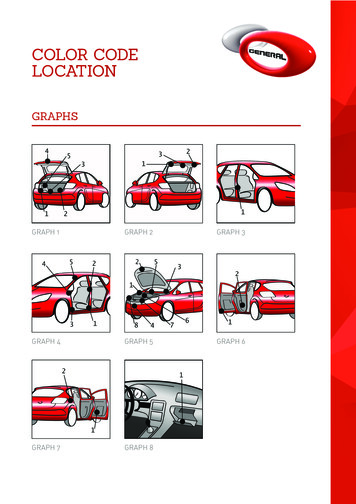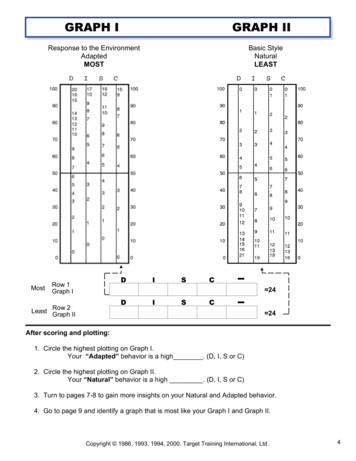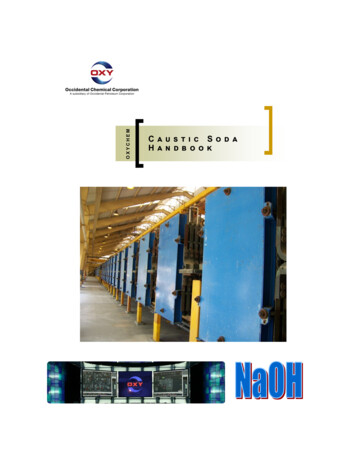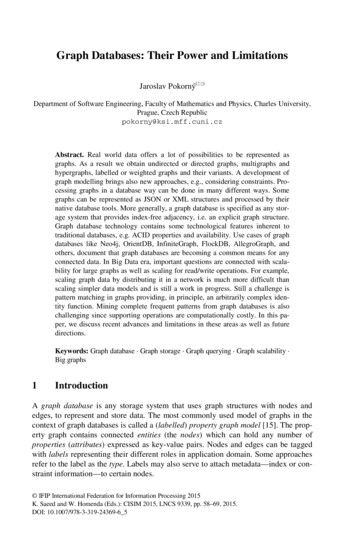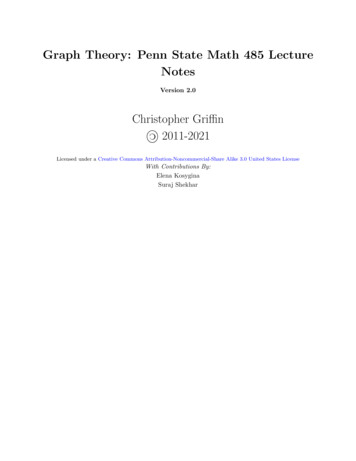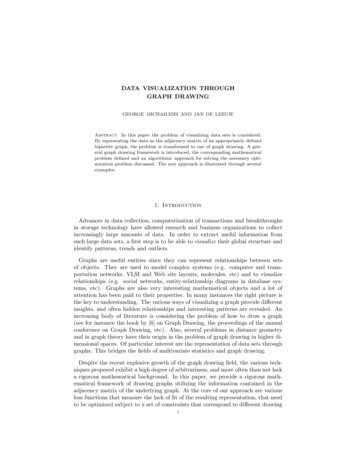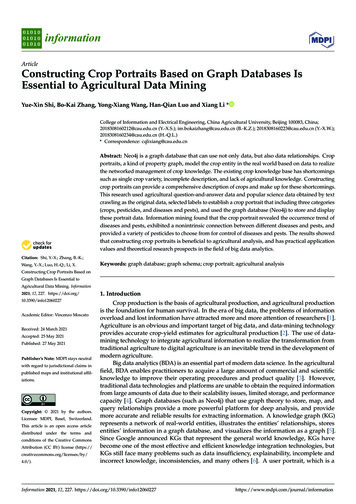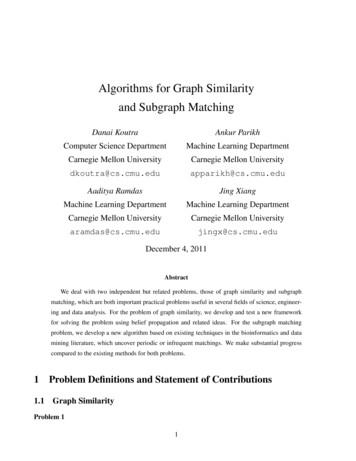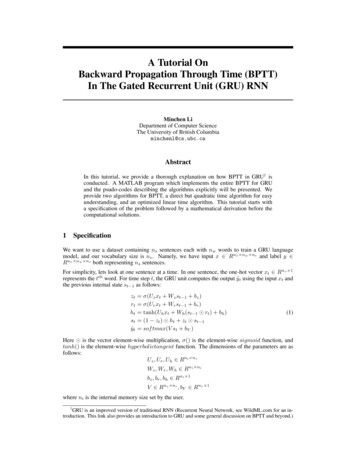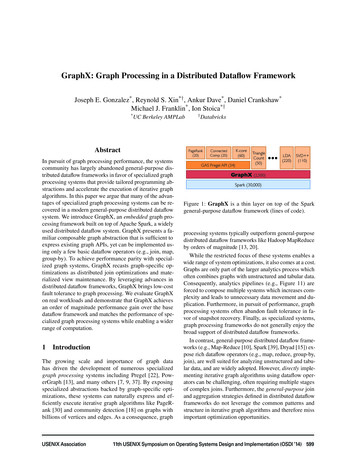
Transcription
GraphX: Graph Processing in a Distributed Dataflow FrameworkJoseph E. Gonzalez* , Reynold S. Xin*† , Ankur Dave* , Daniel Crankshaw*Michael J. Franklin* , Ion Stoica*†* UCBerkeley AMPLabAbstractIn pursuit of graph processing performance, the systemscommunity has largely abandoned general-purpose distributed dataflow frameworks in favor of specialized graphprocessing systems that provide tailored programming abstractions and accelerate the execution of iterative graphalgorithms. In this paper we argue that many of the advantages of specialized graph processing systems can be recovered in a modern general-purpose distributed dataflowsystem. We introduce GraphX, an embedded graph processing framework built on top of Apache Spark, a widelyused distributed dataflow system. GraphX presents a familiar composable graph abstraction that is sufficient toexpress existing graph APIs, yet can be implemented using only a few basic dataflow operators (e.g., join, map,group-by). To achieve performance parity with specialized graph systems, GraphX recasts graph-specific optimizations as distributed join optimizations and materialized view maintenance. By leveraging advances indistributed dataflow frameworks, GraphX brings low-costfault tolerance to graph processing. We evaluate GraphXon real workloads and demonstrate that GraphX achievesan order of magnitude performance gain over the basedataflow framework and matches the performance of specialized graph processing systems while enabling a widerrange of computation.1IntroductionThe growing scale and importance of graph datahas driven the development of numerous specializedgraph processing systems including Pregel [22], PowerGraph [13], and many others [7, 9, 37]. By exposingspecialized abstractions backed by graph-specific optimizations, these systems can naturally express and efficiently execute iterative graph algorithms like PageRank [30] and community detection [18] on graphs withbillions of vertices and edges. As a consequence, graphUSENIX . (20)!K-core!(60)!GAS Pregel API (34)!Triangle!Count!(50)!LDA! SVD !(220)! (110)!GraphX (2,500)!Spark (30,000) !Figure 1: GraphX is a thin layer on top of the Sparkgeneral-purpose dataflow framework (lines of code).processing systems typically outperform general-purposedistributed dataflow frameworks like Hadoop MapReduceby orders of magnitude [13, 20].While the restricted focus of these systems enables awide range of system optimizations, it also comes at a cost.Graphs are only part of the larger analytics process whichoften combines graphs with unstructured and tabular data.Consequently, analytics pipelines (e.g., Figure 11) areforced to compose multiple systems which increases complexity and leads to unnecessary data movement and duplication. Furthermore, in pursuit of performance, graphprocessing systems often abandon fault tolerance in favor of snapshot recovery. Finally, as specialized systems,graph processing frameworks do not generally enjoy thebroad support of distributed dataflow frameworks.In contrast, general-purpose distributed dataflow frameworks (e.g., Map-Reduce [10], Spark [39], Dryad [15]) expose rich dataflow operators (e.g., map, reduce, group-by,join), are well suited for analyzing unstructured and tabular data, and are widely adopted. However, directly implementing iterative graph algorithms using dataflow operators can be challenging, often requiring multiple stagesof complex joins. Furthermore, the general-purpose joinand aggregation strategies defined in distributed dataflowframeworks do not leverage the common patterns andstructure in iterative graph algorithms and therefore missimportant optimization opportunities.11th USENIX Symposium on Operating Systems Design and Implementation (OSDI ’14) 599
Historically, graph processing systems evolved separately from distributed dataflow frameworks for severalreasons. First, the early emphasis on single stage computation and on-disk processing in distributed dataflow frameworks (e.g., MapReduce) limited their applicability toiterative graph algorithms which repeatedly and randomlyaccess subsets of the graph. Second, early distributeddataflow frameworks did not expose fine-grained controlover the data partitioning, hindering the application ofgraph partitioning techniques. However, new in-memorydistributed dataflow frameworks (e.g., Spark and Naiad)expose control over data partitioning and in-memory representation, addressing some of these limitations.Given these developments, we believe there is an opportunity to unify advances in graph processing systems withadvances in dataflow systems enabling a single systemto address the entire analytics pipeline. In this paper weexplore the design of graph processing systems on top ofgeneral purpose distributed dataflow systems. We arguethat by identifying the essential dataflow patterns in graphcomputation and recasting optimizations in graph processing systems as dataflow optimizations we can recoverthe advantages of specialized graph processing systemswithin a general-purpose distributed dataflow framework.To support this argument we introduce GraphX, an efficient graph processing framework embedded within theSpark [39] distributed dataflow system.GraphX presents a familiar, expressive graph API (Section 3). Using the GraphX API we implement a variantof the popular Pregel abstraction as well as a range ofcommon graph operations. Unlike existing graph processing systems, the GraphX API enables the composition ofgraphs with unstructured and tabular data and permits thesame physical data to be viewed both as a graph and ascollections without data movement or duplication. For example, using GraphX it is easy to join a social graph withuser comments, apply graph algorithms, and expose theresults as either collections or graphs to other procedures(e.g., visualization or rollup). Consequently, GraphX enables users to adopt the computational pattern (graph orcollection) that is best suited for the current task withoutsacrificing performance or flexibility.We built GraphX as a library on top of Spark (Figure 1)by encoding graphs as collections and then expressingthe GraphX API on top of standard dataflow operators.GraphX requires no modifications to Spark, revealinga general method to embed graph computation withindistributed dataflow frameworks and distill graph computation to a specific join–map–group-by dataflow pattern.By reducing graph computation to a specific pattern weidentify the critical path for system optimization.However, naively encoding graphs as collections andexecuting iterative graph computation using generalpurpose dataflow operators can be slow and inefficient.To achieve performance parity with specialized graph processing systems, GraphX introduces a range of optimizations (Section 4) both in how graphs are encoded as collections as well as the execution of the common dataflowoperators. Flexible vertex-cut partitioning is used to encode graphs as horizontally partitioned collections andmatch the state of the art in distributed graph partitioning.GraphX recasts system optimizations developed in thecontext of graph processing systems as join optimizations(e.g., CSR indexing, join elimination, and join-site specification) and materialized view maintenance (e.g., vertexmirroring and delta updates) and applies these techniquesto the Spark dataflow operators. By leveraging logicalpartitioning and lineage, GraphX achieves low-cost faulttolerance. Finally, by exploiting immutability GraphXreuses indices across graph and collection views and overmultiple iterations, reducing memory overhead and improving system performance.We evaluate GraphX on real-world graphs and compareagainst direct implementations of graph algorithms usingthe Spark dataflow operators as well as implementationsusing specialized graph processing systems. We demonstrate that GraphX can achieve performance parity withspecialized graph processing systems while preservingthe advantages of a general-purpose dataflow framework.In summary, the contributions of this paper are:1. an integrated graph and collections API which issufficient to express existing graph abstractions andenable a much wider range of computation.2. an embedding of vertex-cut partitioned graphs in horizontally partitioned collections and the GraphX APIin a small set of general-purpose dataflow operators.3. distributed join and materialized view optimizationsthat enable general-purpose distributed dataflowframeworks to execute graph computation at performance parity with specialized graph systems.4. a large-scale evaluation on real graphs and common benchmarking algorithms comparing GraphXagainst widely used graph processing systems.2BackgroundIn this section we review the design trade-offs and limitations of graph processing systems and distributed dataflowframeworks. At a high level, graph processing systemsdefine computation at the granularity of vertices and theirneighborhoods and exploit the sparse dependency structure pre-defined by the graph. In contrast, general-purposedistributed dataflow frameworks define computation asdataflow operators at either the granularity of individualitems (e.g., filter, map) or across entire collections (i.e., operations like non-broadcast join that require a shuffle).600 11th USENIX Symposium on Operating Systems Design and Implementation (OSDI ’14)USENIX Association
2.1The Property Graph Data ModelGraph processing systems represent graph structured dataas a property graph [33], which associates user-definedproperties with each vertex and edge. The properties caninclude meta-data (e.g., user profiles and time stamps)and program state (e.g., the PageRank of vertices or inferred affinities). Property graphs derived from naturalphenomena such as social networks and web graphs oftenhave highly skewed, power-law degree distributions andorders of magnitude more edges than vertices [18].In contrast to dataflow systems whose operators(e.g., join) can span multiple collections, operations ingraph processing systems (e.g., vertex programs) are typically defined with respect to a single property graph witha pre-declared, sparse structure. While this restricted focus facilitates a range of optimizations (Section 2.3), italso complicates the expression of analytics tasks thatmay span multiple graphs and sub-graphs.2.2The Graph-Parallel AbstractionAlgorithms ranging from PageRank to latent factor analysis iteratively transform vertex properties based on theproperties of adjacent vertices and edges. This commonpattern of iterative local transformations forms the basis of the graph-parallel abstraction. In the graph-parallelabstraction [13], a user-defined vertex program is instantiated concurrently for each vertex and interacts with adjacent vertex programs through messages (e.g., Pregel [22])or shared state (e.g., PowerGraph [13]). Each vertex program can read and modify its vertex property and in somecases [13, 20] adjacent vertex properties. When all vertexprograms vote to halt the program terminates.As a concrete example, in Listing 1 we express thePageRank algorithm as a Pregel vertex program. Thevertex program for the vertex v begins by summing themessages encoding the weighted PageRank of neighboring vertices. The PageRank is updated using the resultingsum and is then broadcast to its neighbors (weighted bythe number of links). Finally, the vertex program assesseswhether it has converged (locally) and votes to halt.The extent to which vertex programs run concurrentlydiffers across systems. Most systems (e.g., [7, 13, 22, 34])adopt the bulk synchronous execution model, in whichall vertex programs run concurrently in a sequence ofsuper-steps. Some systems (e.g., [13, 20, 37]) also support an asynchronous execution model that mitigates theeffect of stragglers by running vertex programs as resources become available. However, the gains due to anasynchronous programming model are often offset bythe additional complexity and so we focus on the bulksynchronous model and rely on system level techniques(e.g., pipelining and speculation) to address stragglers.USENIX Associationdef PageRank(v: Id, msgs: List[Double]) {// Compute the message sumvar msgSum 0for (m - msgs) { msgSum m }// Update the PageRankPR(v) 0.15 0.85 * msgSum// Broadcast messages with new PRfor (j - OutNbrs(v)) {msg PR(v) / NumLinks(v)send msg(to j, msg)}// Check for terminationif (converged(PR(v))) voteToHalt(v)}Listing 1: PageRank in Pregel: computes the sum of theinbound messages, updates the PageRank value for thevertex, and then sends the new weighted PageRank valueto neighboring vertices. Finally, if the PageRank did notchange the vertex program votes to halt.While the graph-parallel abstraction is well suited foriterative graph algorithms that respect the static neighborhood structure of the graph (e.g., PageRank), it is notwell suited to express computation where disconnectedvertices interact or where computation changes the graphstructure. For example, tasks such as graph constructionfrom raw text or unstructured data, graph coarsening, andanalysis that spans multiple graphs are difficult to expressin the vertex centric programming model.2.3Graph System OptimizationsThe restrictions imposed by the graph-parallel abstractionalong with the sparse graph structure enable a range ofimportant system optimizations.The GAS Decomposition: Gonzalez et al. [13] observed that most vertex programs interact with neighboring vertices by collecting messages in the form of ageneralized commutative associative sum and then broadcasting new messages in an inherently parallel loop. Theyproposed the GAS decomposition which splits vertex programs into three data-parallel stages: Gather, Apply, andScatter. In Listing 2 we decompose the PageRank vertexprogram into the Gather, Apply, and Scatter stages.The GAS decomposition leads to a pull-based model ofmessage computation: the system asks the vertex programfor value of the message between adjacent vertices ratherthan the user sending messages directly from the vertex program. As a consequence, the GAS decompositionenables vertex-cut partitioning, improved work balance,serial edge-iteration [34], and reduced data movement.However, the GAS decomposition also prohibits directcommunication between vertices that are not adjacent inthe graph and therefore hinders the expression of moregeneral communication patterns.11th USENIX Symposium on Operating Systems Design and Implementation (OSDI ’14) 601
def Gather(a: Double, b: Double) a bdef Apply(v, msgSum) {PR(v) 0.15 0.85 * msgSumif (converged(PR(v))) voteToHalt(v)}def Scatter(v, j) PR(v) / NumLinks(v)Listing 2: Gather-Apply-Scatter (GAS) PageRank:The gather phase combines inbound messages. The applyphase consumes the final message sum and updates thevertex property. The scatter phase defines the messagecomputation for each edge.Graph Partitioning: Graph processing systems applya range of graph-partitioning algorithms [16] to minimizecommunication and balance computation. Gonzalez etal. [13] demonstrated that vertex-cut [12] partitioningperforms well on many large natural graphs. Vertex-cutpartitioning evenly assigns edges to machines in a waythat minimizes the number of times each vertex is cut.Mirror Vertices: Often high-degree vertices will havemultiple neighbors on the same remote machine. Ratherthan sending multiple, typically identical, messagesacross the network, graph processing systems [13, 20,24, 32] adopt mirroring techniques in which a single message is sent to the mirror and then forwarded to all theneighbors. Graph processing systems exploit the staticgraph structure to reuse the mirror data structures.Active Vertices: As graph algorithms proceed, vertexprograms within a graph converge at different rates, leading to rapidly shrinking working sets (the collection ofactive vertex programs). Recent systems [11, 13, 20, 22]track active vertices and eliminate data movement andunnecessary computation for vertices that have converged.In addition, these systems typically maintain efficientdensely packed data-structures (e.g., compressed sparserow (CSR)) that enable constant-time access to the localedges adjacent to active vertices.2.44. a runtime that can tolerate stragglers and partial cluster failures without restarting.In MapReduce, the programming model exposes onlytwo dataflow operators: map and reduce (a.k.a., group-by).Each job can contain at most two layers in its DAG oftasks. More modern frameworks such as DryadLINQ [15],Pig [29], and Spark expose additional dataflow operatorssuch as fold and join, and can execute tasks with multiplelayers of dependencies.Distributed dataflow frameworks have enjoyed broadadoption for a wide variety of data processing tasks, including ETL, SQL query processing, and iterative machine learning. They have also been shown to scale tothousands of nodes operating on petabytes of data.In this work we restrict our attention to Apache Spark,upon which we developed GraphX. Spark has severalfeatures that are particularly attractive for GraphX:1. The Spark storage abstraction called Resilient Distributed Datasets (RDDs) enables applications tokeep data in memory, which is essential for iterativegraph algorithms.2. RDDs permit user-defined data partitioning, andthe execution engine can exploit this to co-partitionRDDs and co-schedule tasks to avoid data movement.This is essential for encoding partitioned graphs.3. Spark logs the lineage of operations used to buildan RDD, enabling automatic reconstruction of lostpartitions upon failures. Since the lineage graph isrelatively small even for long-running applications,this approach incurs negligible runtime overhead,unlike checkpointing, and can be left on without concern for performance. Furthermore, Spark supportsoptional in-memory distributed replication to reducethe amount of recomputation on failure.4. Spark provides a high-level API in Scala that can beeasily extended. This aided in creating a coherentAPI for both collections and graphs.Distributed Dataflow FrameworksWe use the term distributed dataflow framework to refer tocluster compute frameworks like MapReduce and its generalizations. Although details vary from one frameworkto another, they typically satisfy the following properties:We believe that many of the ideas in GraphX couldbe applied to other contemporary dataflow systems andin Section 6 we discuss some preliminary work on aGraphLINQ, a graph framework within Naiad.1. a data model consisting of typed collections (i.e., ageneralization of tables to unstructured data).32. a coarse-grained data-parallel programming modelcomposed of deterministic operators which transform collections (e.g., map, group-by, and join).We now revisit graph computation from the perspectiveof a general-purpose dataflow framework. We recast theproperty graph data model as collections and the graphparallel abstraction as a specific pattern of dataflow operators. In the process we reveal the essential structure ofgraph-parallel computation and identify the key operatorsrequired to execute graph algorithms efficiently.3. a scheduler that breaks each job into a directedacyclic graph (DAG) of tasks, where each task runson a (horizontal) partition of data.The GraphX Programming Abstraction602 11th USENIX Symposium on Operating Systems Design and Implementation (OSDI ’14)USENIX Association
3.1Property Graphs as CollectionsThe property graph, described in Section 2.1, can be logically represented as a pair of vertex and edge property collections. The vertex collection contains the vertex properties uniquely keyed by the vertex identifier. In the GraphXsystem, vertex identifiers are 64-bit integers which maybe derived externally (e.g., user ids) or by applying a hashfunction to the vertex property (e.g., page URL). Theedge collection contains the edge properties keyed by thesource and destination vertex identifiers.By reducing the property graph to a pair of collectionswe make it possible to compose graphs with other collections in a distributed dataflow framework. Operationslike adding additional vertex properties are naturally expressed as joins against the vertex property collection.The process of analyzing the results of graph computation(i.e., the final vertex and edge properties) and comparingproperties across graphs becomes as simple as analyzingand joining the corresponding collections. Both of thesetasks are routine in the broader scope of graph analyticsbut are not well served by the graph parallel abstraction.New property graphs can be constructed by composing different vertex and edge property collections. Forexample, we can construct logically distinct graphs withseparate vertex properties (e.g., one storing PageRanksand another storing connected component membership)while sharing the same edge collection. This may appearto be a small accomplishment, but the tight integrationof vertices and edges in specialized graph processingsystems often hinders even this basic form of reuse. In addition, graph-specific index data structures can be sharedacross graphs with common vertex and edge collections,reducing storage overhead and improving performance.3.2Graph Computation as Dataflow Ops.The normalized representation of a property graph as apair of vertex and edge property collections allows usto embed graphs in a distributed dataflow framework. Inthis section we describe how dataflow operators can becomposed to express graph computation.Graph-parallel computation, introduced in Section 2.2,is the process of computing aggregate properties of theneighborhood of each vertex (e.g., the sum of the PageRanks of neighboring vertices weighted by the edge values). We can express graph-parallel computation in a distributed dataflow framework as a sequence of join stagesand group-by stages punctuated by map operations.In the join stage, vertex and edge properties are joinedto form the triplets view1 consisting of each edge and itscorresponding source and destination vertex properties.1The triplet terminology derives from the classic Resource Description Framework (RDF), discussed in Section 6.USENIX AssociationCREATE VIEW triplets ASSELECT s.Id, d.Id, s.P, e.P, d.PFROM edges AS eJOIN vertices AS s JOIN vertices AS dON e.srcId s.Id AND e.dstId d.IdListing 3: Constructing Triplets in SQL: The column Prepresents the properties in the vertex and edge propertycollections.The triplets view is best illustrated by the SQL statementin Listing 3, which constructs the triplets view as a threeway join keyed by the source and destination vertex ids.In the group-by stage, the triplets are grouped by sourceor destination vertex to construct the neighborhood ofeach vertex and compute aggregates. For example, tocompute the PageRank of a vertex we would execute:SELECT t.dstId, 0.15 0.85*sum(t.srcP*t.eP)FROM triplets AS t GROUP BY t.dstIdBy iteratively applying the above query to update thevertex properties until they converge, we can calculate thePageRank of each vertex.These two stages capture the GAS decomposition described in Section 2.3. The group-by stage gathers messages destined to the same vertex, an intervening mapoperation applies the message sum to update the vertexproperty, and the join stage scatters the new vertex property to all adjacent vertices.Similarly, we can implement the GAS decompositionof the Pregel abstraction by iteratively composing the joinand group-by stages with data-parallel map stages. Eachiteration begins by executing the join stage to bind activevertices with their outbound edges. Using the triplets view,messages are computed along each triplet in a map stageand then aggregated at their destination vertex in a groupby stage. Finally, the messages are received by the vertexprograms in a map stage over the vertices.The dataflow embedding of the Pregel abstractiondemonstrates that graph-parallel computation can be expressed in terms of a simple sequence of join and group-bydataflow operators. Additionally, it stresses the need toefficiently maintain the triplets view in the join stage andcompute the neighborhood aggregates in the group-bystage. Consequently, these stages are the focus of performance optimization in graph processing systems. Wedescribe how to implement them efficiently in Section 4.3.3GraphX OperatorsThe GraphX programming abstraction extends the Sparkdataflow operators by introducing a small set of specialized graph operators, summarized in Listing 4.11th USENIX Symposium on Operating Systems Design and Implementation (OSDI ’14) 603
class Graph[V, E] {// Constructordef Graph(v: Collection[(Id, V)],e: Collection[(Id, Id, E)])// Collection viewsdef vertices: Collection[(Id, V)]def edges: Collection[(Id, Id, E)]def triplets: Collection[Triplet]// Graph-parallel computationdef mrTriplets(f: (Triplet) M,sum: (M, M) M): Collection[(Id, M)]// Convenience functionsdef mapV(f: (Id, V) V): Graph[V, E]def mapE(f: (Id, Id, E) E): Graph[V, E]def leftJoinV(v: Collection[(Id, V)],f: (Id, V, V) V): Graph[V, E]def leftJoinE(e: Collection[(Id, Id, E)],f: (Id, Id, E, E) E): Graph[V, E]def subgraph(vPred: (Id, V) Boolean,ePred: (Triplet) Boolean): Graph[V, E]def reverse: Graph[V, E]}Listing 4: Graph Operators: transform vertex and edgecollections.The Graph constructor logically binds together a pairof vertex and edge property collections into a propertygraph. It also verifies the integrity constraints: that everyvertex occurs only once and that edges do not link missingvertices. Conversely, the vertices and edges operators expose the graph’s vertex and edge property collections. The triplets operator returns the triplets view(Listing 3) of the graph as described in Section 3.2. If atriplets view already exists, the previous triplets are incrementally maintained to avoid a full join (see Section 4.2).The mrTriplets (Map Reduce Triplets) operator encodes the essential two-stage process of graphparallel computation defined in Section 3.2. Logically, themrTriplets operator is the composition of the mapand group-by dataflow operators on the triplets view. Theuser-defined map function is applied to each triplet, yielding a value (i.e., a message of type M) which is then aggregated at the destination vertex using the user-definedbinary aggregation function as illustrated in the following:SELECT t.dstId, reduceF(mapF(t)) AS msgSumFROM triplets AS t GROUP BY t.dstIdThe mrTriplets operator produces a collection containing the sum of the inbound messages keyed by thedestination vertex identifier. For example, in Figure 2 weuse the mrTriplets operator to compute a collectioncontaining the number of older followers for each userin a social network. Because the resulting collection contains a subset of the vertices in the graph it can reuse thesame indices as the original vertex collection.Finally, Listing 4 contains several functions that sim-B 2342 ASourcePropertyCResultingVertices19 DE 75F 16TargetProperty42mapF(30A23BMessageto vertex B) 1Vertex IdPropertyA0B2C1D1E0F3val graph: Graph[User, Double]def mapUDF(t: Triplet[User, Double]) if (t.src.age t.dst.age) 1 else 0def reduceUDF(a: Int, b: Int): Int a bval seniors: Collection[(Id, Int)] graph.mrTriplets(mapUDF, reduceUDF)Figure 2: Example use of mrTriplets: Compute the number of older followers of each vertex.def Pregel(g: Graph[V, E],vprog: (Id, V, M) V,sendMsg: (Triplet) M,gather: (M, M) M): Collection[V] {// Set all vertices as activeg g.mapV((id, v) (v, halt false))// Loop until convergencewhile (g.vertices.exists(v !v.halt)) {// Compute the messagesval msgs: Collection[(Id, M)] // Restrict to edges with active sourceg.subgraph(ePred (s,d,sP,eP,dP) !sP.halt)// Compute messages.mrTriplets(sendMsg, gather)// Receive messages and run vertex programg g.leftJoinV(msgs).mapV(vprog)}return g.vertices}Listing 5: GraphX Enhanced Pregel: An implementation of the Pregel abstraction using the GraphX API.ply perform a dataflow operation on the vertex or edgecollections. We define these functions only for caller convenience; they are not essential to the abstraction and caneasily be defined using standard dataflow operators. Forexample, mapV is defined as follows:g.mapV(f) Graph(g.vertices.map(f), g.edges)In Listing 5 we use the GraphX API to implement aGAS decomposition of the Pregel abstraction. We beginby initializing the vertex properties with an additionalfield to track active vertices (those that have not votedto halt). Then, while there are active vertices, messagesare computed using the mrTriplets operator and thevertex program is applied to the resulting message sums.By expressing message computation as an edgeparallel map operation followed by a commutative associative aggregation, we leverage the GAS decomposition604 11th USENIX Symposium on Operating Systems Design and Implementation (OSDI ’14)USENIX Association
def ConnectedComp(g: Graph[V, E]) {g g.mapV(v v.id) // Initialize verticesdef vProg(v: Id, m: Id): Id {if (v m) voteToHalt(v)return min(v, m)}def sendMsg(t: Triplet): Id if (t.src.cc t.dst.cc) t.src.ccelse None // No message requireddef gatherMsg(a: Id, b: Id): Id min(a, b)return Pregel(g, vProg, sendMsg, gatherMsg)}Listing 6: Connected Components: For each vertex wecompute the lowest reachable vertex id using Pregel.to mitigate the cost of high-degree vertices. Furthermore,by exposing the entire triplet to the message computationwe can simplify algorithms like connected components.However, in cases where the entire triplet is not needed(e.g., PageRank which requires only the source property)we rely on UDF bytecode inspection (see Section 4.3.2)to automatically drop unused fields from join.In Listing 6 we use the GraphX variant of Pregel toimplement the connected components algorithm. The connected components algorithm computes the lowes
dataflow frameworks did not expose fine-grained control over the data partitioning, hindering the application of graph partitioning techniques. However, new in-memory distributed dataflow frameworks (e.g., Spark and Naiad) expose control over data partitioning and in-memory rep-resentation, addressing some of these limitations.
